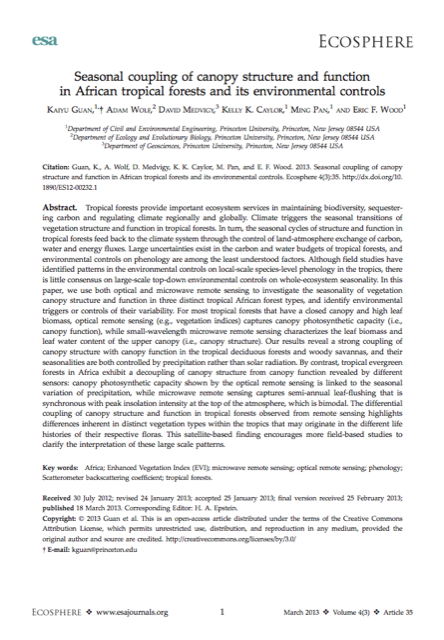Seasonal coupling of canopy structure and function in African tropical forests and its environmental controls

∗Guan, K., Wolf, A., Medvigy, D., Caylor, K.K., Pan, M., Wood, E.F., (2013) “Seasonal coupling of canopy structure and function in African tropical forests and its environmental controls”,Ecosphere 4:art35. doi:10.1890/ES12-00232.1
Tropical forests provide important ecosystem services in maintaining biodiversity, sequestering carbon and regulating climate regionally and globally. Climate triggers the seasonal transitions of vegetation structure and function in tropical forests. In turn, the seasonal cycles of structure and function in tropical forests feed back to the climate system through the control of land-atmosphere exchange of carbon, water and energy fluxes. Large uncertainties exist in the carbon and water budgets of tropical forests, and environmental controls on phenology are among the least understood factors. Although field studies have identified patterns in the environmental controls on local-scale species-level phenology in the tropics, there is little consensus on large-scale top-down environmental controls on whole-ecosystem seasonality. In this paper, we use both optical and microwave remote sensing to investigate the seasonality of vegetation canopy structure and function in three distinct tropical African forest types, and identify environmental triggers or controls of their variability. For most tropical forests that have a closed canopy and high leaf biomass, optical remote sensing (e.g., vegetation indices) captures canopy photosynthetic capacity (i.e., canopy function), while small-wavelength microwave remote sensing characterizes the leaf biomass and leaf water content of the upper canopy (i.e., canopy structure). Our results reveal a strong coupling of canopy structure with canopy function in the tropical deciduous forests and woody savannas, and their seasonalities are both controlled by precipitation rather than solar radiation. By contrast, tropical evergreen forests in Africa exhibit a decoupling of canopy structure from canopy function revealed by different sensors: canopy photosynthetic capacity shown by the optical remote sensing is linked to the seasonal variation of precipitation, while microwave remote sensing captures semi-annual leaf-flushing that is synchronous with peak insolation intensity at the top of the atmosphere, which is bimodal. The differential coupling of canopy structure and function in tropical forests observed from remote sensing highlights differences inherent in distinct vegetation types within the tropics that may originate in the different life histories of their respective floras. This satellite-based finding encourages more field-based studies to clarify the interpretation of these large scale patterns.
